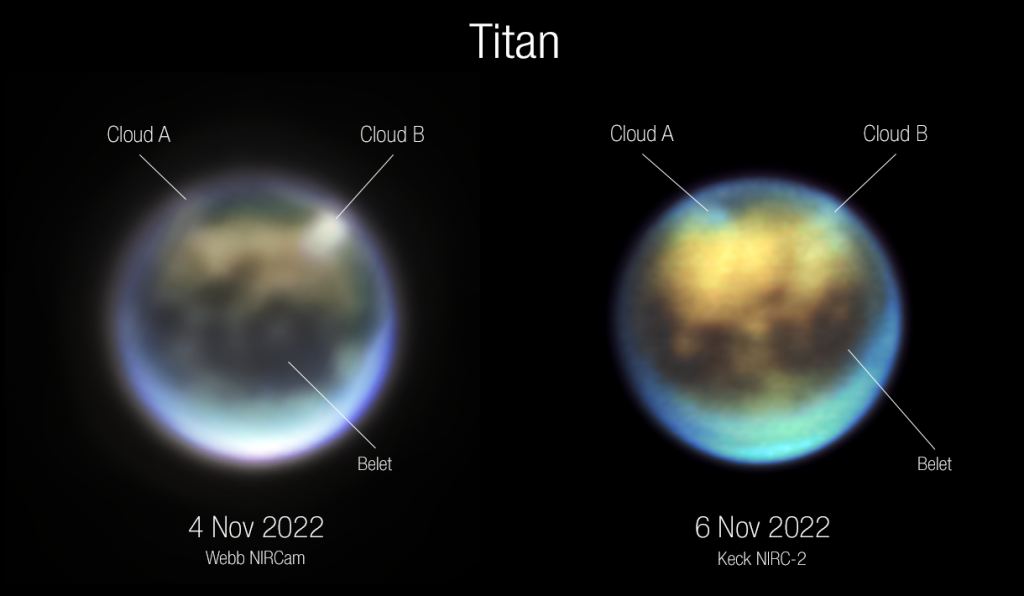Planetary scientists have greatly anticipated using the James Webb Space Telescope’s infrared vision to study Saturn’s enigmatic moon Titan and its atmosphere. The wait is finally over and the results are spectacular. Plus, JWST had a little help from one of its ground-based observatory friends in helping to decode some strange features in the new images.
Turns out, JWST had just imaged a rare event on Titan: clouds. In these new images, the white areas near the top of Titan are clouds, likely made from methane. The clouds appear to have formed over Titan’s northern region, known to have lakes made of liquid hydrocarbons.
Images of Saturn’s moon Titan, captured by the James Webb Space Telescope’s NIRCam instrument Nov. 4, 2022. Left: Image using F212N, a 2.
12-micron filter sensitive to Titan’s lower atmosphere. The bright spots are prominent clouds in the northern hemisphere. Right: Color composite image using a combination of NIRCam filters: Blue=F140M (1.
40 microns), Green=F150W (1. 50 microns), Red=F200W (1. 99 microns), Brightness=F210M (2.
09 microns). Several prominent surface features are labeled: Kraken Mare is thought to be a methane sea; Belet is composed of dark-colored sand dunes; Adiri is a bright albedo feature. Image credit: NASA, ESA, CSA, A.
Pagan (STScI). Science: Webb Titan GTO Team. Titan’s nitrogen-rich atmosphere covers the moon like a shroud, as it is 50% denser than Earth’s atmosphere and visible light cannot penetrate it.
But astronomers have figured out ingenious ways to see through the atmosphere – using radar, infrared techniques, and other tricks (more on that later), enabling them to see details in Titan’s atmosphere and amazingly, even down to surface to see features like dunes, as well as the hydrocarbon rivers and lakes. While astronomers have been able to detect clouds in Titan’s atmosphere since 1995, according to planetary scientist Sarah Hörst, it’s rare and Titan can go years and years without detectable clouds. For JWST to see them at its first go at Titan is remarkable – with maybe a little luck thrown in.
JWST imaged Titan on November 4. A NASA blog post details how Sebastien Rodriguez from the Universite Paris Cité was the first to see the new images when the data arrived to Earth, and Rodriguez alerted the rest of the team in an email: “What a wake-up this morning (Paris time)! Lots of alerts in my mailbox! I went directly to my computer and started at once to download the data. At first glance, it is simply extraordinary! I think we’re seeing a cloud!” JWST Solar System GTO Project Lead Heidi Hammel, from the Association of Universities for Research in Astronomy (AURA), had a similar reaction: “Fantastic! Love seeing the cloud and the obvious albedo markings.
So looking forward to the spectra! Congrats, all!!! Thank you!” The team quickly called in colleagues at the Keck Telescope on Mauna Kea in Hawai’i to perform follow-up observations. A series of Keck images taken about 30 and 54 hours after JWST’s showed similar clouds — likely the same ones — but slightly displaced because of the moon’s rotation relative to Earth. “We were concerned that the clouds would be gone when we looked at Titan one and two days later with Keck, but to our delight there were clouds at the same positions, looking like they might have changed in shape,” said Imke de Pater, a UC Berkeley Professor of the Graduate School, in a press release.
The astronomers cautioned, however, that since clouds are not long-lasting on Titan or Earth, so those seen on November 4 by JWST may not be the same as those seen on November 7 by Keck. Evolution of clouds on Titan over 30 hours between Nov. 4 and Nov.
6, as seen by near-infrared cameras on the James Webb Space Telescope (top) and Keck Telescope. Titan’s trailing hemisphere seen here is rotating from left (dawn) to right (evening) as seen from Earth and the sun. Cloud A appears to be rotating into view, while Cloud B appears to be either dissipating, or moving behind Titan’s limb.
Clouds are not long-lasting on Titan or Earth, so those seen on Nov. 4 may not be the same as those seen on Nov. 6.
(Image credit: NASA/STScI/Keck Observatory/Judy Schmidt) Titan is the only moon in the Solar System with a dense atmosphere and the only planetary body other than Earth that currently has surface features like rivers, lakes and seas. Unlike Earth, however, the liquid on Titan’s surface is composed of hydrocarbons including methane and ethane, not water. The new and continued observations of Titan from JWST, combined with those from Earth-bound telescopes, will help astronomers understand the weather patterns on Titan.
Additionally, the upcoming mission to this moon, scheduled for launch in 2027 called Dragonfly, will also provide more insights. Dragonfly has a multirotor lander and will assess the habitability of Titan’s unique environment. For some additional info on how astronomers use every trick the book to see through Titan’s thick atmosphere — and how clouds were first seen on that moon — the Planet Dr, Sarah Hörst has a great thread on Twitter explaining it all: Anyone want a quick Titan cloud thread?— Dr.
/Prof. Sarah Hörst (@PlanetDr) December 1, 2022 The science team that used JWST to study Titan are still working through their data, and so these observations are still a work in progress, and the team stressed their work has not yet been through the peer-review process. The post New Images of Titan From JWST and Keck Telescopes Reveal a Rare Observation appeared first on Universe Today.
.
From: universetoday
URL: https://www.universetoday.com/158941/new-images-of-titan-from-jwst-and-keck-telescopes-reveal-a-rare-observation/



